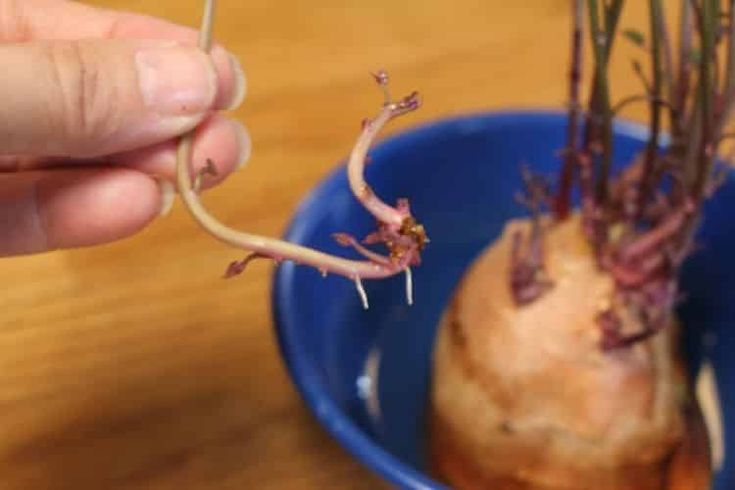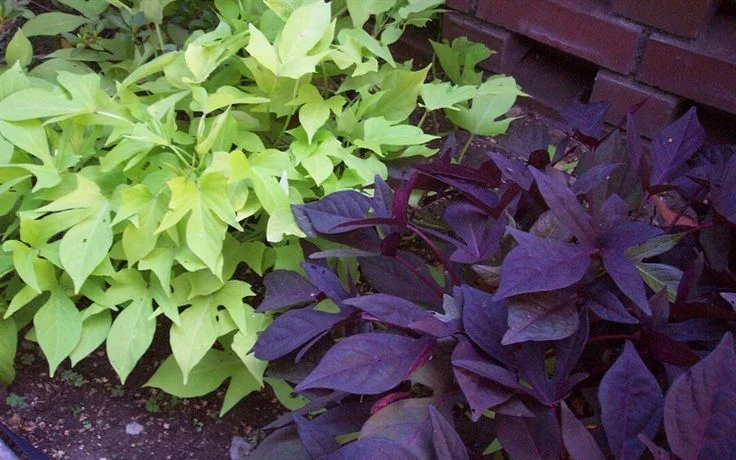Whether it’s grown in a garden, a simple pot, or on a trellis, a sweet potato plant or Ipomoea batatas is a sight to behold. That’s not even the end of the benefits, though. Incorporating sweet potatoes into your diet is a good idea because of their positive effect on your health. If you are interested in cultivating them in your backyard, here is a guide to assist you.
Sweet potato plant: Key facts
| Plant Type | Annual Vegetable |
| Plant Family | Convolvulaceae (Morning Glory) |
| Plant Species | Ipomoea batatas |
| Plant Genus | Ipomoea |
| Planting Season | Late spring or early summer |
| Plant Maintenance | Moderate |
| Plant Height | 12-15” |
| Fertility Needs | Low |
| Temperature | 75° and 95°F is ideal |
| Companion Plants | Parsnips, beets, beans |
| Soil Type | Well-drained loam |
| Plant Spacing | 10-18” apart in rows |
| Watering Needs | Needs consistent moisture |
| Sun Exposure | Full sun |
| Days to Maturity | 90 to 150 days |
| Pests | Wireworms, Sweet Potato Beetles |
| Diseases | Scurf and rot |
Known about Edible Roots
Sweet potato plant: Features

Source: Pinterest
The sweet potato plant is a creeping vine that is branched and crawls along the ground. It has lobed, heart-shaped leaves that are organised spirally and white or lavender blooms. Tubers are larger roots found on the plant and serve to store the plant’s excess energy. The tubers can have a variety of shapes.
This tropical plant requires a minimum of 4 months of hot weather and temperate soil, yet it is highly resistant to drought, temperature, pests and diseases. When prepared for consumption, sweet potatoes are most frequently mashed or roasted in their entirety. You may also use them as the filling for a pie.
Sweet potato plant: Varieties
Although orange-fleshed sweet potato cultivars develop the quickest, white, yellow, and even purple-fleshed varieties are all viable options. When cooked, orange-fleshed types release their moisture; white and yellow turn creamy; purple sweet potatoes get dry and starchy.
Sweet potato plant: What are sweet potato slips?

Source: Pinterest
There is no way to start a crop of sweet potatoes from seed. As an alternative, slips, which are just sprouts developed from mature sweet potatoes, are used. Garden centres, greenhouses, local produce, and mail-order companies all stock slips for their customers.
Try checking the duration of your growing season to ensure that sweet potatoes can be grown before placing your slip order. The typical maturation period for most types is between 90 and 120 days. In addition, arrange your purchase around your planting times for optimal results.
Sweet potato plant: Ideal location for sweet potato plant

Source: Pinterest
Find a location that gets plenty of sunlight and has soil that drains properly. Sweet potatoes aren’t fussy about their growing conditions, but they do fare better in sandy soil. They require a substantial amount of atmosphere in the soil for their roots to penetrate deeper. Start expanding in raised beds if the soil in your yard is heavy clay, rough, or compacted.
To create a rich, loamy environment, soil amendments like compost, perlite, and coconut coir can be worked into the top 8-10 inches of growing space. Don’t use any kind of animal manure, even powdered chicken manure, because it can cause your plants to grow roots that are too thin and/or discoloured. It’s best to keep away from high-nitrogen fertilisers as well, as they encourage the growth of edible leaves but not edible roots.
Sweet potato plant: Timing for planting sweet potatoes
Slips can be planted outside 3–4 weeks after the last spring frost or when the soil reaches a temperature of at least 65 °F (18 °C). Ideally, the temperature at night would be around 55 degrees Fahrenheit (13 degrees Celsius). The difficulty is to place them before a late April frost destroys them before they reach full maturity.
Early sweet potatoes should be protected against late frosts and cool nights (below 55°F/13°C) because they are easily damaged. Cover them at night with plastic milk bottles or use row wraps, then uncover them in the morning.
Open the box containing your slips right away if you ordered them online. The roots only need to be submerged in moisture for a night or two to recover. You should sow them as quickly as possible.
Sweet potato plant: How to grow?

Source: Pinterest
In place of purchasing slips, you might begin your own, albeit this will require more effort on your part. Specifically, here’s what you do:
- Search for organic sweet potatoes free of blemishes and wrinkles around eight weeks before your region’s average spring frost date. Inquire about the variety and ensure you’d like to cultivate it.
- Plant the sweet potatoes entirely into containers or bins with at least three inches of loose, organic soil that drains well. Spread out the sweet potatoes, giving them a couple of inches of room between them.
- Add a couple of inches of soil on top and lightly cover. Keep the soil moist but not waterlogged by watering now and as needed.
- Keep the soil and environment at a temperature of 75–80 degrees Fahrenheit, either in direct sunlight or with artificial lighting. If you don’t have access to a stove, a heating mat will suffice; sweet potatoes thrive in warm conditions.
- Eventually, shoots, or “slips,” will poke through the ground.
- Within 6-8 weeks, the slips will have several leaves and roots and be about 6 to 12 inches long.
- Those sweet potatoes with their roots still attached should have their slips removed.
- When it is too early to plant outside, you can keep the slips moist by placing them in potting mixture or sand.
- Before you plant the slips outside, let them harden off in filtered sunshine for a week or two.
Procedures for planting sweet potatoes
- Make elevated mounds that are between 6 and 8 inches in height and roughly 12 inches broad.
- It is recommended to leave a spacing of three feet between each mound to allow for the growth of vines.
- When the topsoil temperature gets 60 degrees Fahrenheit (15 degrees Celsius), you should sow the slips on a sunny day with gloomy skies.
- Remove the leaves from the lower branches, keeping just the highest ones.
- The slips should be set at a sufficient depth to encompass the roots and the stems up to the foliage. The nodes are where the sweet potatoes will develop.
- To ensure that the plants have healthy roots, water them with a liquid fertiliser high in phosphorus and then continue to water them abundantly over the next 7–10 days.
Sweet potato plant: Maintenance
- Apply a side dressing of 5-10-10 fertilizer to plants around three to four weeks after planting. Use a greater quantity if the soil is sandy.
- After planting the sweet potatoes, wait two weeks before beginning your normal weeding of the beds.
- Take care not to dig too deeply with a shovel or any other tool that could damage the sensitive feeder roots.
- Maintain a consistent watering schedule, particularly in the middle of the summer. Increasing your watering depth during hot, dry weather will boost your yields.
- Sweet potato vines should not have any pruning done to them because they should be very strong.
- At the end of the growing season, cut back on watering to prevent the skin of the sweet from cracking, which can be an issue during storage.
Sweet potato plant: Harvesting

Source: Pinterest
- Once the roots have reached a size where they are suitable for consumption, you can begin digging them up.
- Gather your crop around the 100-day mark after planting, when the leaflets and tips have begun to turn yellow.
- To prevent harm to the roots, loosen up the soil around the plant by 18 inches all the way around and four to six inches deep. Wipe off some of the creeping plants.
- To get to the roots, you’ll need to pull up the plant’s main crown and dig them out by hand. You must be gentle when handling sweet potatoes because they easily get bruised.
- If there is excess dirt, shake it out, but don’t wash the roots.
- Finish harvesting before the first frost of the season.
Sweet potato plant: Health benefits
- When compared to white potatoes, sweet potatoes have a higher fibre content, which may result in more consistent blood glucose levels.
- You may have heard that carrots are good for your eyes, but there is another orange vegetable that may have the same effect. Sweet potatoes’ high vitamin A content suggests that they may contribute to healthy eyes.
- The same beta-carotene that helps your eyesight may also help your body fight inflammation. As an antioxidant, beta-carotene helps clean the cells in the body of inflammation-free radicals, which is why it is so beneficial.
- The health benefits of eating lots of sweet potatoes, which are rich in beta-carotene, may not be limited to specific organs or systems. Multiple studies have linked low beta carotene levels to increased cardiovascular disease, heart failure, and mortality risk.
- You should eat sweet potatoes when you have gastrointestinal problems, including bloating, gas, or diarrhoea. The soluble fibre in sweet potatoes facilitates intestinal regularity.
FAQs
What is the average yield of sweet potatoes from a single plant?
On average, you should be capable of harvesting three to five tubers from each sweet potato plant which is equivalent to one to two pounds. On the other hand, if you reside somewhere in a warmer environment, you might be capable of harvesting six or even more tubers from one plant.
What conditions are necessary for the growth of sweet potato plants?
Find a place that gets plenty of sunlight and has good drainage. There should be a lot of room for their roots to spread out and grow into the ground. Use raised beds if your soil is heavy with clay, rocky, or packed.
Is it possible for a sweet potato to sprout into its own plant?
Assuming an ideal environment, the sprouts will take hold and begin to grow into a new plant. Sweet potatoes will emerge from dormancy when exposed to warm, humid conditions.
Housing News Desk is the news desk of leading online real estate portal, Housing.com. Housing News Desk focuses on a variety of topics such as real estate laws, taxes, current news, property trends, home loans, rentals, décor, green homes, home improvement, etc. The main objective of the news desk, is to cover the real estate sector from the perspective of providing information that is useful to the end-user.
Facebook: https://www.facebook.com/housing.com/
Twitter: https://twitter.com/Housing
Email: [email protected]











